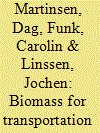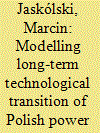|
|
|
Sort Order |
|
|
|
Items / Page
|
|
|
|
|
|
|
| Srl | Item |
| 1 |
ID:
093477


|
|
|
|
|
| Publication |
2010.
|
| Summary/Abstract |
The introduction of biofuels from biomass for transport purposes in an energy system model shows that bioethanol and vegetable oil can compete with oil products without subsidies provided prices of imported energy carriers are high, i.e. crude oil prices around $ 100/bbl. About half of the biomass will be used for motor fuel substitutes, whose share of the final energy in the transportation sector will increase to 10% in 2030. This gives rise to a nearly 9% drop in CO2 emissions in the transportation sector as compared to an emission balance where all real local emissions are fully counted. Despite a strong enhancement of biomass and biomass fuels and quite high prices for oil and gas up to 2030, BtL products like synthetic gasoline and diesel from biomass do not play an important part in the model results unless fairly high penalties are set for CO2 emissions. In the case of global CO2 penalties below Euro 300/tco2 the use of biomass will even shift away from vehicle fuel production to biomass power plants and CHP. A CO2 penalty above Euro 100/tco2 in the transportation sector only, will, however, trigger the production of liquids and synthesis gases from biomass for use as BtL.
|
|
|
|
|
|
|
|
|
|
|
|
|
|
|
|
| 2 |
ID:
117250


|
|
|
|
|
| Publication |
2013.
|
| Summary/Abstract |
The UK has a target for an 80% reduction in CO2 emissions by 2050 from a 1990 base. Domestic energy use accounts for around 30% of total emissions. This paper presents a comprehensive review of existing models and modelling techniques and indicates how they might be improved by considering individual buying behaviour. Macro (top-down) and micro (bottom-up) models have been reviewed and analysed. It is found that bottom-up models can project technology diffusion due to their higher resolution. The weakness of existing bottom-up models at capturing individual green technology buying behaviour has been identified. Consequently, Markov chains, neural networks and agent-based modelling are proposed as possible methods to incorporate buying behaviour within a domestic energy forecast model. Among the three methods, agent-based models are found to be the most promising, although a successful agent approach requires large amounts of input data. A prototype agent-based model has been developed and tested, which demonstrates the feasibility of an agent approach. This model shows that an agent-based approach is promising as a means to predict the effectiveness of various policy measures.
|
|
|
|
|
|
|
|
|
|
|
|
|
|
|
|
| 3 |
ID:
105751


|
|
|
|
|
| Publication |
2011.
|
| Summary/Abstract |
This paper describes a method to model the influence by global policy scenarios, particularly spillover of technology learning, on the energy service demand of the non-energy sectors of the national economy. It is exemplified by Norway. Spillover is obtained from the technology-rich global Energy Technology Perspective model operated by the International Energy Agency. It is provided to a national hybrid model where a national bottom-up Markal model carries forward spillover into a national top-down CGE1 model at a disaggregated demand category level. Spillover of technology learning from the global energy technology market will reduce national generation costs of energy carriers. This may in turn increase demand in the non-energy sectors of the economy because of the rebound effect. The influence of spillover on the Norwegian economy is most pronounced for the production level of industrial chemicals and for the demand for electricity for residential energy services. The influence is modest, however, because all existing electricity generating capacity is hydroelectric and thus compatible with the low emission policy scenario. In countries where most of the existing generating capacity must be replaced by nascent energy technologies or carbon captured and storage the influence on demand is expected to be more significant.
|
|
|
|
|
|
|
|
|
|
|
|
|
|
|
|
| 4 |
ID:
150049


|
|
|
|
|
| Summary/Abstract |
The need for technological transition of electricity production becomes a global problem. However, in coal-dominated Polish power system this need is even more crucial than anywhere, since technical lifetime of the most domestic power plants is ending. In this paper, the impact of the EU Emission Trading Scheme (EU ETS) for CO2 combined with sulfur dioxide (SO2) and nitrogen oxides (NOx) emission trading mechanism on power technology choice was studied using Market Allocation (MARKAL) model of Polish power system. Poland can contribute to achieving ambitious EU CO2 emission reduction goals to 2050 by switching to diversified electricity mix of low-carbon coal technologies with CCS, and carbon-free options e.g. nuclear, biomass IGCC, wind onshore and offshore. This ‘low-carbon’ mix can be achieved only at high emission allowance prices, stimulated by the introduction of Market Stability Reserve to EU ETS and successive decrease in EU CO2 emission cap. At high emission allowance prices, Poland's CO2 emissions from ETS-participating electricity generating plants are expected to decrease in 2010–2050 period by 96–99%, depending on the projected electricity consumption. Model results prove that SO2/NOx emission trading scheme, envisaged in Poland, is not effective, in view of Industrial Emission Directive implementation, and should be reconsidered.
|
|
|
|
|
|
|
|
|
|
|
|
|
|
|
|
| 5 |
ID:
127882


|
|
|
|
|
| Publication |
2014.
|
| Summary/Abstract |
Several projects in the European Union (EU) are currently under development to implement the carbon capture, transport and storage (CCS) technology on a large scale and may be subject to public funding under EU support initiatives. These CCS projects may develop any combination of three types of operating levels: pilot, demonstration and full-scale, representing progressing levels of electric power generation capability. Several projects have commenced at the demonstration level, with full-scale commercial levels planned for approximately 2020. Taking the perspective of a funding agency, we employ a real options framework for determining an optimal project selection and funding strategy for the development of full-scale CCS plants. Specifically, we formulate and solve a stochastic dynamic program (SDP) for obtaining optimal funding solutions in order to achieve at least one successfully operating full-scale CCS plant by a target year. The model demonstrates the improved risk reduction by employing such a multi-stage competition. We then extend the model to consider two sensitivities: (1) the flexibility to spend that budget among the time periods and (2) optimizing the budget, but specifying each time period's allocation a priori. State size and runtimes of the SDP model are provided
|
|
|
|
|
|
|
|
|
|
|
|
|
|
|
|
|
|
|
|
|